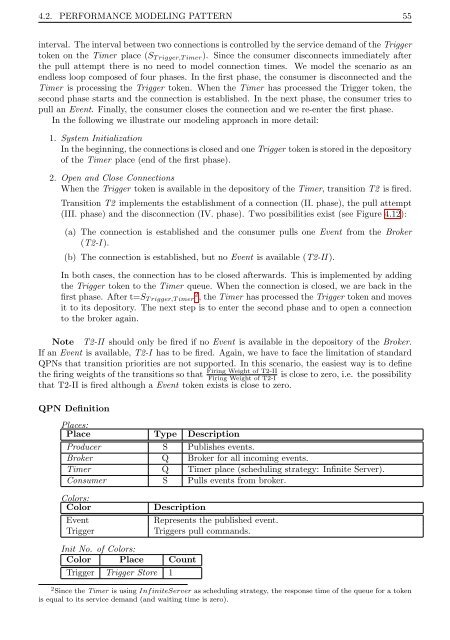Performance Modeling and Benchmarking of Event-Based ... - DVS
Performance Modeling and Benchmarking of Event-Based ... - DVS
Performance Modeling and Benchmarking of Event-Based ... - DVS
You also want an ePaper? Increase the reach of your titles
YUMPU automatically turns print PDFs into web optimized ePapers that Google loves.
4.2. PERFORMANCE MODELING PATTERN 55<br />
interval. The interval between two connections is controlled by the service dem<strong>and</strong> <strong>of</strong> the Trigger<br />
token on the Timer place (S T rigger,T imer ). Since the consumer disconnects immediately after<br />
the pull attempt there is no need to model connection times. We model the scenario as an<br />
endless loop composed <strong>of</strong> four phases. In the first phase, the consumer is disconnected <strong>and</strong> the<br />
Timer is processing the Trigger token. When the Timer has processed the Trigger token, the<br />
second phase starts <strong>and</strong> the connection is established. In the next phase, the consumer tries to<br />
pull an <strong>Event</strong>. Finally, the consumer closes the connection <strong>and</strong> we re-enter the first phase.<br />
In the following we illustrate our modeling approach in more detail:<br />
1. System Initialization<br />
In the beginning, the connections is closed <strong>and</strong> one Trigger token is stored in the depository<br />
<strong>of</strong> the Timer place (end <strong>of</strong> the first phase).<br />
2. Open <strong>and</strong> Close Connections<br />
When the Trigger token is available in the depository <strong>of</strong> the Timer, transition T2 is fired.<br />
Transition T2 implements the establishment <strong>of</strong> a connection (II. phase), the pull attempt<br />
(III. phase) <strong>and</strong> the disconnection (IV. phase). Two possibilities exist (see Figure 4.12):<br />
(a) The connection is established <strong>and</strong> the consumer pulls one <strong>Event</strong> from the Broker<br />
(T2-I ).<br />
(b) The connection is established, but no <strong>Event</strong> is available (T2-II ).<br />
In both cases, the connection has to be closed afterwards. This is implemented by adding<br />
the Trigger token to the Timer queue. When the connection is closed, we are back in the<br />
first phase. After t=S T rigger,T imer 2 , the Timer has processed the Trigger token <strong>and</strong> moves<br />
it to its depository. The next step is to enter the second phase <strong>and</strong> to open a connection<br />
to the broker again.<br />
Note T2-II should only be fired if no <strong>Event</strong> is available in the depository <strong>of</strong> the Broker.<br />
If an <strong>Event</strong> is available, T2-I has to be fired. Again, we have to face the limitation <strong>of</strong> st<strong>and</strong>ard<br />
QPNs that transition priorities are not supported. In this scenario, the easiest way is to define<br />
Firing Weight <strong>of</strong> T2-II<br />
the firing weights <strong>of</strong> the transitions so that<br />
Firing Weight <strong>of</strong> T2-I<br />
is close to zero, i.e. the possibility<br />
that T2-II is fired although a <strong>Event</strong> token exists is close to zero.<br />
QPN Definition<br />
Places:<br />
Place Type Description<br />
Producer S Publishes events.<br />
Broker Q Broker for all incoming events.<br />
Timer Q Timer place (scheduling strategy: Infinite Server).<br />
Consumer S Pulls events from broker.<br />
Colors:<br />
Color<br />
<strong>Event</strong><br />
Trigger<br />
Description<br />
Represents the published event.<br />
Triggers pull comm<strong>and</strong>s.<br />
Init No. <strong>of</strong> Colors:<br />
Color Place Count<br />
Trigger Trigger Store 1<br />
2 Since the Timer is using InfiniteServer as scheduling strategy, the response time <strong>of</strong> the queue for a token<br />
is equal to its service dem<strong>and</strong> (<strong>and</strong> waiting time is zero).















